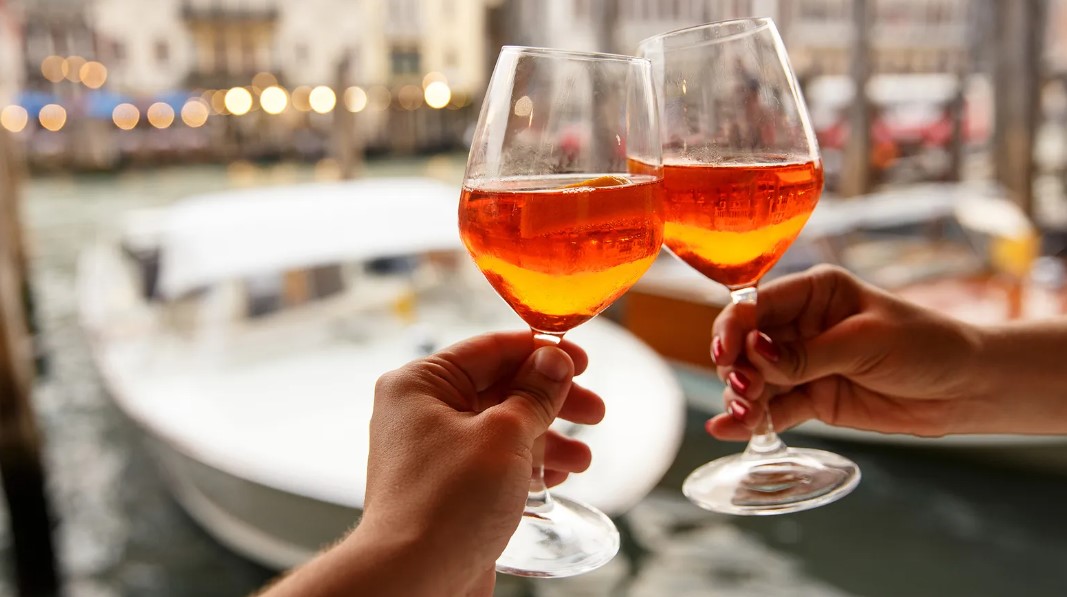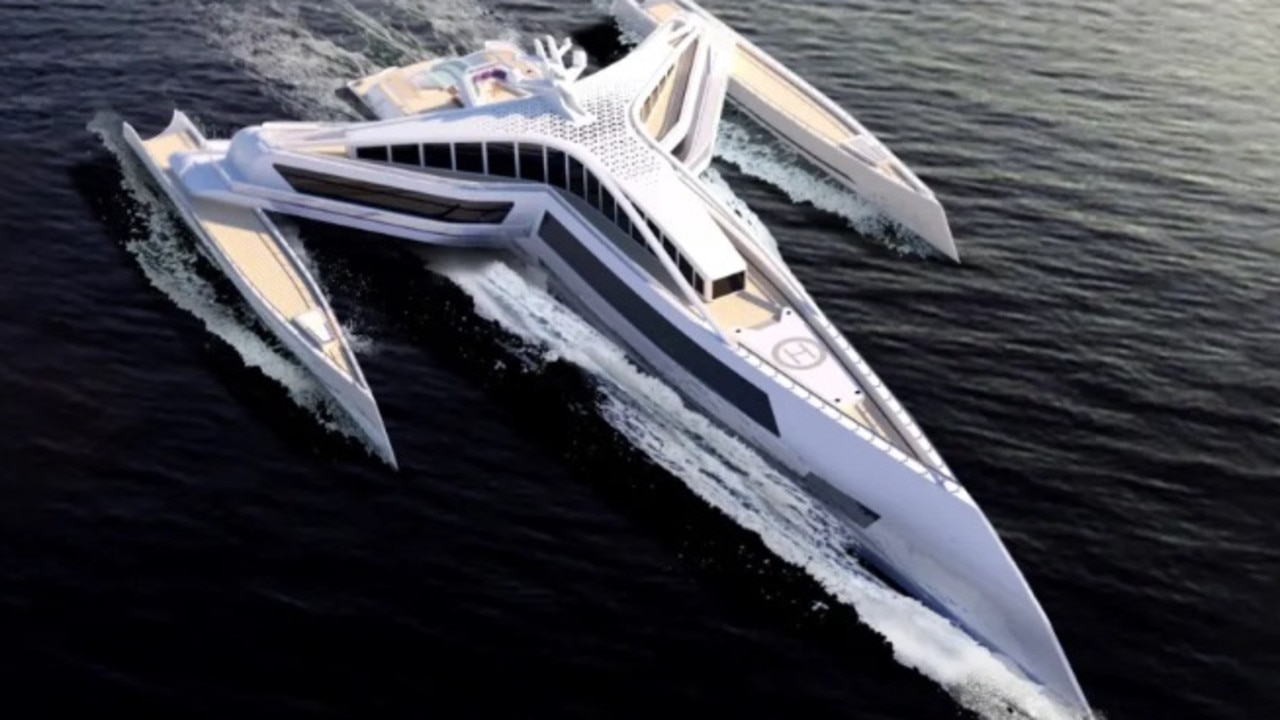Aperol’s sudden rise to fame has some locals in Venice scratching their heads. How is it that a beverage that, twenty years ago, was only served in dive bars all across the world has now become so ubiquitous?
From the rooftop of the Independent Art Fair in Tribeca to the flamingo-themed new bakery on my Brooklyn block, Aperol Spritz has been flowing freely this summer at New York City’s most delightful places. You can go on an Aperol Spritz bar crawl in Singapore, and you can find it with the native pastis and kir at most cafes in Paris.
Aperitivo, Italy’s beloved pre-dinner drink, now seems to be the equivalent of the American happy hour. However, we Venetians are a little bewildered by the present popularity of Aperol Spritz. How was it that a beverage that was once exclusively available at the osteria (tavern) and cheap local taverns of our region suddenly become a global phenomenon only 20 years ago?
The Venetian aperitivo was recently voted Italy’s favorite pre-dinner drink, and it can be prepared in under three minutes with half a glass of prosecco, a third of a glass of bitter liqueur, ice cubes, and a splash of seltzer (added in this order, so that the bubbles naturally burble up), and a big, juicy olive or an orange slice for garnish. Minister of the Italian government Eugenia Roccella blamed it for a population decline, claiming that young couples must now decide between “drinking spritz and having kids” because of its rising popularity. Star Wars actress Zendaya is just one celebrity in the United States who has made the orange tint of Aperol Spritz-colored nail lacquer a trend.
However, the first spritz didn’t have an orange flavor. The practice of “Spritzen,” in which sparkling water is added to a glass of white wine, has its origins in the 19th century, when Austria seized Venice in 1797 and dominated it for decades. The Austrians did not care for the heavy Venetian wine, Malvasia. Venetians later decided that watered-down wine was too light, so they began to add Aperol, Select, Campari, or Cynar (listed in order of sweetest to most bitter) to their prosecco, according to Giuseppe Zanon, bartender and co-owner of the historic Al Mercà café (Campo Bella Vienna, 213) near the Rialto Bridge.
After seven years of experimenting with macerating sour orange peels, gentian root, rhubarb, and spices in their father’s distillery, brothers Luigi and Silvio Barbieri created Aperol in the adjacent city of Padova in 1919. It is currently by far the most popular spritz liqueur around the world. Because of its low alcohol content (11%), it was initially marketed in the 1920s to drinkers who wished to stay in shape, and later in the 1930s, the slogan “Signora! Aperol keeps you thin” was used to market it specifically to women. By the 1980s, it had become a staple drink at every bar in the Veneto region, and its popularity had spread to the Po Valley, where cities like Padova, Venice, Treviso, and Vicenza continued the tradition with their own slight variations on the classic spritz.
According to Roberto Pasini, author of the 2013 pamphlet A Guide to Spritz, “Aperol Spritz was the drink of the old salts and the old drunks, the ones at the bar who (I say this with the deepest affection) would say a curse every three words.” Rock tumblers “which were indestructible and could be slammed downon the counter of the osteria” were used to serve the beverage.
However, the inexpensive and lively drink caught on with more than just rowdy elderly men. In the late ’90s, it was common for rowdy student groups to gather in Padova’s medieval squares and the cobblestone backstreets of the ancient ghetto on Friday nights to drink Aperol spritzes and Campari spritzes out of plastic cups. The olive garnish often served as dinner, providing a convenient excuse to socialize and stay out late.
Sir Oliver Skardy, whom I can only describe as our Venetian Bob Marley, sang about the osteria in his song Fame un Spritz (Make Me a Spritz), describing it as a “real oasis” where young and old would go to play cards, eat, drink, and have a good time in the stifling heat of a Venetian summer.
Campari bought Aperol in 2003 to strengthen its position in the Venetian market. As a final stroke of creative brilliance, it also introduced this regional aperitivo to a few of Milanese bars, where it is now served in a balloon-shaped glass rather than the traditional osteria-style rock tumbler.
When I first saw the new glass in bars 20 years ago, I had a similar reaction to that of Julka Villa, CMO of the Campari Group and a native of Veneto: “A brave choice, but rather annoying.” It was a bold, potentially game-changing business decision, despite its unnatural appearance as a kind of Milan-isation of a down-home Venetian tradition.
Having “visibility and dignity” thanks to the glass, as Villa put it. This glass was used to transport the drink from the lowly osteria to the sophisticated bar lounge. Paduan “medieval barfly” of the 12th century drinking establishments were no longer the intended consumers; rather, it was the aspiring and fashion-conscious Milanese. Because no one slams their glasses on the counter any more, manufacturers can make them more flimsy.
The once-affordable “spritz” is now a “luxury for yuppies,” as Skardy observed. Aperol’s meteoric rise, like an orange tidal wave, was unstoppable, since its obvious appeal lay in its color and flavor, as noted by food expert Eleonora Cozzella. It’s the color of a warm summer evening, thus it has a consistent color scheme. “When I hear Aperol Spritz, I immediately think of a terrace in Italy, overlooking the Adriatic Sea at sunset,” she said. (It’s such a unique color that Pasini is developing a color chart for amateur bartenders who wish to replicate it).
The fragrant flavor, the herbs, and the citrus are also appreciated,” Cozzella continued. “And who doesn’t like the prosecco and the orange?”
Aperol, Villa said, was a hit with everyone since it was less alcoholic than Campari and appealed to individuals who didn’t know they enjoyed bitter flavors. Aperol was instrumental in spreading the gospel of bitterness across the United States. A generation ago, most Americans wouldn’t have touched bitter foods like kale, dark chocolate, or strong coffee. People are now turning to the internet to answer issues such as, “What the heck is Vermouth?” (a bitter, fortified wine) or “What is red bitter liquor?” to deeper questions like “Can you drink Aperol by yourself?”
However, such widespread success always appears to have some sort of downside. The olive was the unfortunate victim here. The recipe on the Aperol bottle label does not include the olive (just the orange slice garnish) to cater to a global audience that favored the zesty taste of the orange (and, according to Pasini, its cheaper price). If you asked most people who weren’t Italian, they wouldn’t have known olives were even a possibility.
“It’s a big loss for humanity,” Pasini remarked. If you don’t remove the olives from their brine, the saltiness of the olives will complement the sweetness of the dish. It is considered standard practice for every respectable bartender in Venice to include a whole olive, pit and all, in every cocktail they serve. Ultimately, “there is always that awkward moment when you don’t know where to put the pit,” as Cozzella described it. In the napkin? After the chips, please.
Like in his hometown of Treviso, also part of the “spritz archipelago,” Pasini enjoys mixing orange and olive. To add to his litany of complaints, the commercial recipe calls for too much Aperol and ice (see his recipe below for a better alternative). According to him, “a spritz isnot a mojito,” so you only need two ice cubes instead of a full glass. Furthermore, he claims that a straw is unnecessary because a spritz is not a cocktail.
Similar emotions were expressed in conversations with friends and family in Venice, where I grew up. “Most people still drink Aperol Spritz, but Select is on the rise,” said Zanon, the bartender. At 18:00, when his cafe opened, I called him just as he was finishing up making 24 spritzes all at once. I’ve had one too many Aperols,” he said, “and I’m sick of the sweetness.” Select, in his opinion, is experiencing a revival, and he gladly recommends it as “the true Venetian aperitif” anytime a customer requests an aperitif that is less sweet than Campari and more bitter than Aperol.
It appears that Padova is succumbing to the same thirst for compromise. To counteract the sweetness and “excessive ice” of the Aperol Spritz, my childhood friend Laura mixes Campari and Aperol instead. Simone, Laura’s significant other, likes to mix it with 50% Campari and 50% Cynar. But there are also Italians who don’t partake in the spritz or bitter liqueur ritual at all. The people of Schio, a town about 35 kilometers north-east of Vicenza, continue to make spritz the traditional Austrian way, using only wine and seltzer. In addition, a select group of Venice’s more refined organic vineyards have recently said, with a hint of hidden pride, that they are not the type of establishment to sell spritzes since “real connoisseurs” would never dilute their wine with water.
Like most things associated with Italian style, I imagine the answer is not simple. About 85 percent of Italians agree on one thing, though: they simply cannot give up their monthly aperitivo ritual.
“It’s a hymn to slowness,” Cozzella remarked. The need to savor the atmosphere before meals. To eat, drink, and socialize for a while longer before parting ways.
That’s undoubtedly what’s behind the ever-evolving spritz tradition that’s been going strong for 200 years, from the time of the Austrians to the present day: a very Italian, drawn-out and slow search for the ideal flavor of a summer sunset.




